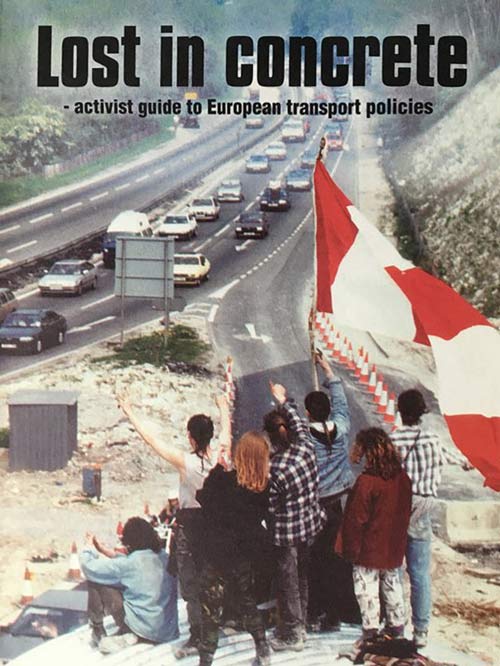
Book Reviews
‘Lost in Concrete - activist guide to European transport policies’
pub ASEED Europe ‘96
A SEED Europe, PO Box 92066, 1090 AB, Amsterdam, The Netherlands.
Tel: 31 20 668 2236.
email: aseedeur@antenna.nl
Squall 14, Autumn 1996, pg. 66.
This book scrutinises European Union transport policies and traces how they have collided to produce the nightmare of Trans-European Networks (TENs).
It looks at the effects of TENs in terms of the decimation of communities, increased incidence of pollution and related asthma; the likely contribution of car emissions to climate change; loss of areas of natural beauty etc etc.
Lost in Concrete does not pretend to be objective. It presents an articulate, well-argued case for not building huge trans-European road networks and looks positively to encouraging and funding alternative means of transport and alternative (local) ways of organising economies so as to reduce the amount of traffic on existing roads.
This is not merely an anti-roads rant. It is well-researched, and with contributions from amongst others Hungary, Greece, Denmark, Belgium and France, a plethora of issues and angles are covered including its effects on our use of space and time. The book asks intelligent and as yet unanswered key questions about the philosophy of huge-scale road building and its relationship to the market economy.
In ‘Life on the Edge’ Tim Richardson calls for an urgent assessment of TENs, arguing that for starters we need to know exactly to whom a single market will bring economic benefits. He notes that contrary to its own logic, the TENs programme is recognised (even it would seem by the European Commission) as highly likely “to drive a wedge between the single market and regional economies”.
‘Bulldozing Jobs’ by Oliver Hoedeman challenges the notion that road building equals job creation and community benefits; and ‘The Culture Killers’ by Ann Doherty examines the ways in which cultural identities in village and farm-based communities throughout Europe are being crushed by the promotion of ‘efficient’ and ‘cheap’ forms of transporting goods.
In ‘Time Pollution’, an excellent chapter on the effects of TENs on our use of space and time, John Whitelegg and Emma Must conclude that rather than saving time TENs will actually “contribute to the modern condition of ‘not having enough time’, the sense of time being squeezed.” Whitelegg and Must also note that whilst access to expensive motors and the price of flights has given the rich wide access to the rest of the country and the world, “the radius of activity ....of many unemployed residents in London or elderly people in Alabama... may be no greater than of urban residents 100 years ago.”
With a really nice A4 layout; loads of black and white pictures and cartoons from all around Europe; positive suggestions for future policy and useful contacts for action and information, this book’ll put you streets ahead of the road-heads.
Sam Beale
